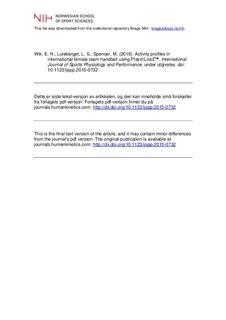| dc.contributor.author | Wik, Eirik Halvorsen | |
| dc.contributor.author | Luteberget, Live | |
| dc.contributor.author | Spencer, Matt | |
| dc.date.accessioned | 2017-04-19T13:26:27Z | |
| dc.date.available | 2017-04-19T13:26:27Z | |
| dc.date.issued | 2016 | |
| dc.identifier.citation | International Journal of Sports Physiology and Performance. 2016, under utgivelse. doi: 10.1123/ijspp.2015-0732 | nb_NO |
| dc.identifier.uri | http://hdl.handle.net/11250/2439157 | |
| dc.description | I Brage finner du siste tekst-versjon av artikkelen, og den kan inneholde ubetydelige forskjeller fra forlagets pdf-versjon. Forlagets pdf-versjon finner du på journals.humankinetics.com / In Brage you'll find the final text version of the article, and it may contain insignificant differences from the journal's pdf version. The definitive version is available at journals.humankinetics.com | nb_NO |
| dc.description.abstract | Team handball matches place diverse physical demands on players, which may result in fatigue and decreased activity levels. However, previous speed-based methods of quantifying player activity may not be sensitive for capturing short-lasting team handball-specific movements. Purpose: To examine activity profiles of a female team handball team and individual player profiles, using inertial measurement units (IMUs). Methods: Match data was obtained from one female national team in nine international matches (n=85 individual player samples), using the Catapult OptimEye S5. PlayerLoad™min-1 was used as a measure of intensity in 5- and 10-minute periods. Team profiles were presented as relative to the player’s match means, and individual profiles were presented as relative to the mean of the 5-minute periods with >60% field time. Results: A high initial intensity was observed for team profiles, and for players with ≥2 consecutive periods of play. Substantial declines in PlayerLoad™ min-1 were observed throughout matches for the team, and for players with several consecutive periods of field time. These trends were found for all positional categories. Intensity increased substantially in the final five minutes of the first half for team profiles. Activity levels were substantially lower in the five minutes after a player’s most intense period, and were partly restored in the subsequent 5-minute period. Discussion: Possible explanations for the observed declines in activity profiles for the team and individual players include fatiguing players, situational factors and pacing. However, underlying mechanisms were not accounted for, and these assumptions are therefore based on previous team-sport studies. | nb_NO |
| dc.language.iso | eng | nb_NO |
| dc.publisher | Human Kinetics | nb_NO |
| dc.subject | training load | nb_NO |
| dc.subject | accelerometer | nb_NO |
| dc.subject | IMU | nb_NO |
| dc.subject | team sports | nb_NO |
| dc.subject | fatigue | nb_NO |
| dc.title | Activity profiles in international female team handball using PlayerLoadTM | nb_NO |
| dc.type | Journal article | nb_NO |
| dc.type | Peer reviewed | nb_NO |
| dc.subject.nsi | VDP::Samfunnsvitenskap: 200::Samfunnsvitenskapelige idrettsfag: 330::Andre idrettsfag: 339 | nb_NO |
| dc.source.journal | International Journal of Sports Physiology and Performance (IJSPP) | nb_NO |
| dc.identifier.doi | 10.1123/ijspp.2015-0732 | |
| dc.description.localcode | Seksjon for fysisk prestasjonsevne / Department of Physical Performance | nb_NO |
